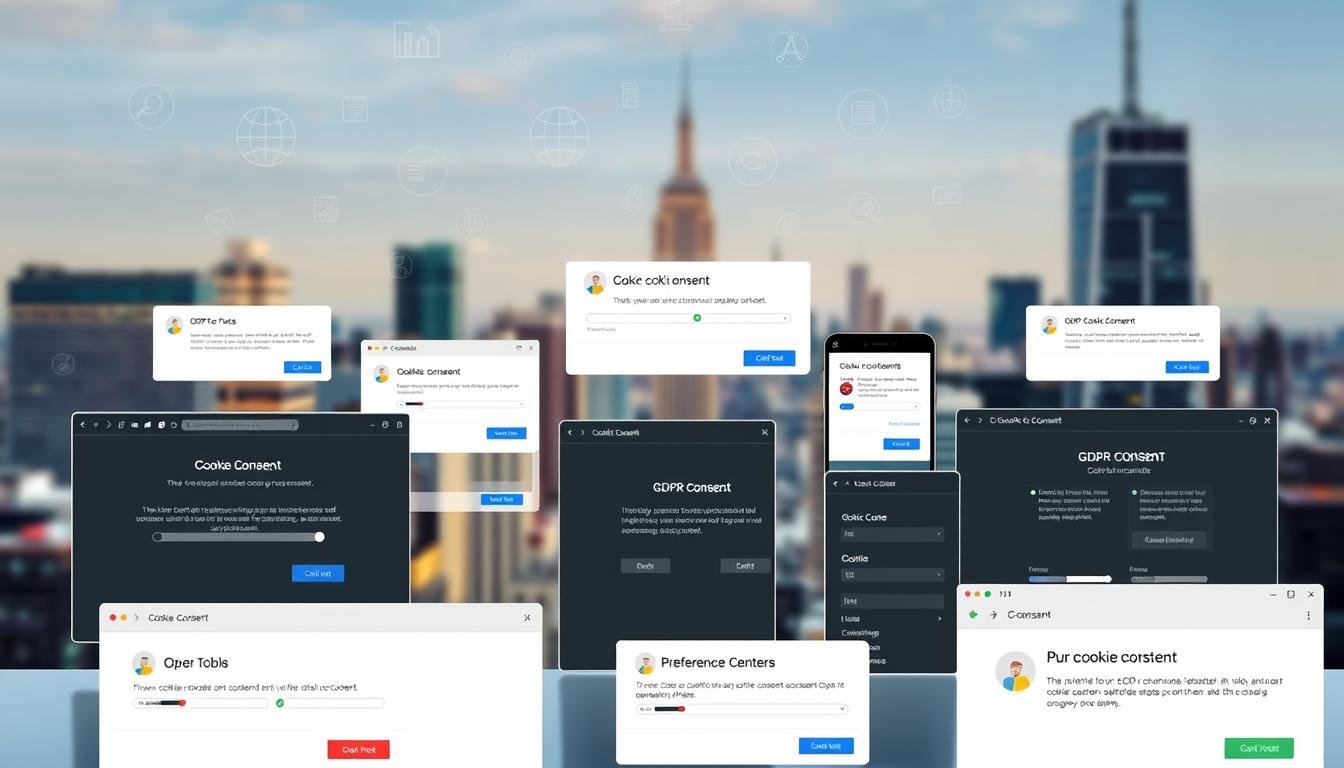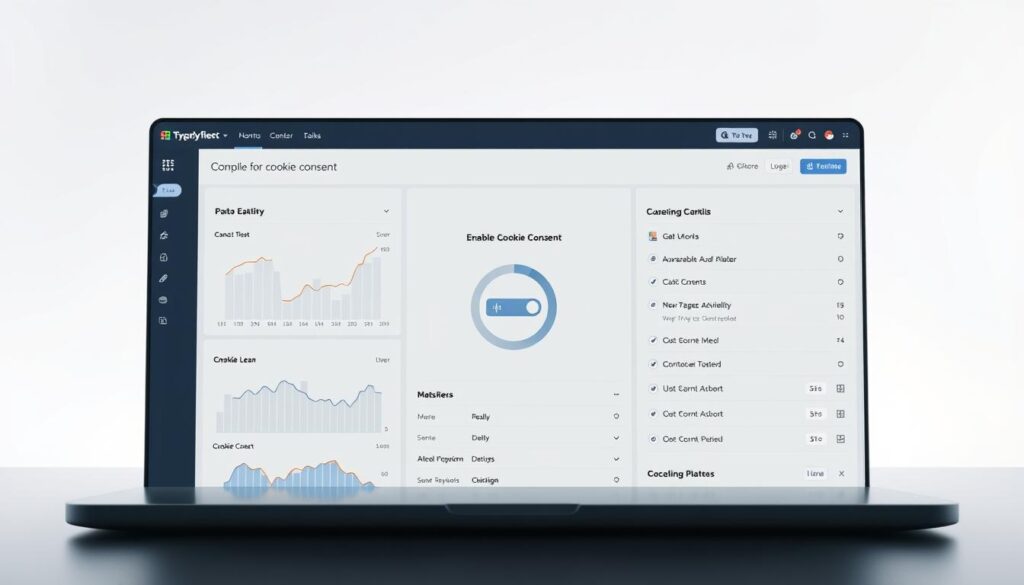In today’s digital age, ensuring your website complies with privacy regulations is no longer optional—it’s essential. Non-compliance can lead to hefty penalties, such as fines up to €20 million or 4% of global revenue. With millions of websites adopting solutions like CookieYes and Termly, the need for compliance has never been more critical.
These tools not only help you meet legal requirements but also enhance user experience by balancing privacy and functionality. Whether you’re managing a small blog or a large e-commerce platform, choosing the right solution can save you from costly mistakes.
This guide will walk you through key evaluation criteria, including customization, automation, and reporting, to help you make an informed decision. Stay ahead of the curve and protect your website’s future.
Key Takeaways
- Non-compliance with privacy laws can result in significant fines.
- Popular solutions like CookieYes and Termly are trusted by millions.
- Balancing legal requirements with user experience is crucial.
- Customization and automation are key features to consider.
- Reporting capabilities help track compliance effectively.
Why GDPR Cookie Consent Tools Are Essential for Compliance
Navigating the complexities of privacy laws requires more than just awareness—it demands action. Businesses must prioritize compliance to avoid severe financial and reputational consequences. Real-world examples, like British Airways’ €20 million fine and Google’s €50 million penalty, highlight the stakes of non-compliance.
Beyond legal penalties, failing to adhere to regulations can damage your brand’s reputation. Audits and public scrutiny can erode customer trust, making recovery difficult. Additionally, non-compliance can lead to secondary risks, such as invalidated analytics and broken third-party integrations, which disrupt business operations.
Tools like Termly offer features like consent logs, which provide audit protection and ensure accountability. Similarly, Cookie Information’s WCAG 2.2-compliant banners help prevent accessibility lawsuits, further safeguarding your business. Investing in these solutions is not just about avoiding fines—it’s about building a foundation of trust and data protection.
In today’s regulatory landscape, staying compliant is non-negotiable. The right tools can simplify the process, protect your business, and enhance user trust. Don’t wait until it’s too late—take proactive steps to secure your website’s future.
Key Features to Look for in GDPR Cookie Consent Tools
Selecting the right features for your website’s compliance solution can make all the difference. The right tools not only ensure adherence to regulations but also enhance user experience. Here are the essential features to consider when evaluating your options.
Customizable Cookie Banners
Customization is crucial for aligning your banners with your brand’s identity. A well-designed banner ensures clarity and encourages user interaction. Tools like CookieYes allow you to adjust colors, fonts, and messaging to match your website’s aesthetic.
Automatic Cookie Blocking
Automatic blocking ensures that no cookies are placed on a user’s device without their approval. This feature is vital for compliance and protects your website from potential risks. It also simplifies the process by handling the technical aspects for you.
Consent Logging and Reporting
Detailed logs and reports are essential for maintaining transparency and accountability. CookieYes generates monthly audit reports, while Termly stores EU data locally for added security. These features help you track user consent and prepare for audits.
For example, Cookie Information’s timestamped logs provide legal evidence, ensuring your compliance efforts are well-documented. Additionally, tools like Termly offer DSAR forms for handling data access requests efficiently.
When comparing report formats, consider whether you need PDF exports or real-time dashboards. CookieYes’ consent dashboard, for instance, offers opt-in rate analytics, giving you valuable insights into user behavior.
By focusing on these features, you can choose a solution that meets your compliance needs while enhancing user trust and transparency.
Top GDPR Cookie Consent Tools in the Market
Finding the right platform for compliance can transform how your website operates. With so many options available, it’s essential to choose a solution that meets your needs while enhancing user experience. Here’s a closer look at three leading platforms in the market.
CookieYes: A Comprehensive Solution
CookieYes stands out as a versatile platform designed for businesses of all sizes. It offers features like Google Consent Mode v2 compatibility, ensuring seamless integration with marketing analytics. Weekly scans and unlimited pageviews make it ideal for enterprises.
Its cookie categorization methodology identifies six types of cookies, providing clarity for users. With WCAG 2.2-certified banners, it ensures accessibility compliance, making it a top choice for businesses prioritizing inclusivity.
Termly: Legal Expertise and Ease of Use
Termly combines legal expertise with user-friendly features, making it a reliable solution for compliance. Its DSAR forms simplify data access requests, while consent logs offer audit protection. This platform is perfect for businesses seeking a balance between functionality and legal accuracy.
Cookie Information: High-Quality Data Capture
Cookie Information excels in capturing user preference without compromising data quality. As a Google CMP Gold Partner, it offers advanced features like real-time dashboards and detailed reports. Its 14-day trial allows businesses to test its capabilities before committing.
One user review states, “Captures consent without sacrificing data quality,” highlighting its effectiveness. For businesses focused on precision and transparency, this platform is a standout choice.
How to Evaluate GDPR Cookie Consent Tools for Your Business
Choosing the right solution for your business starts with a clear evaluation process. By understanding your website’s needs, comparing features, and researching feedback, you can make an informed decision. This ensures you select a tool that aligns with your goals and enhances user trust.
Assessing Your Website’s Needs
Start by identifying your website’s specific requirements. Consider factors like traffic volume, third-party integrations, and customization options. A small blog may need a simple solution, while an e-commerce site requires advanced features like automatic blocking and detailed reporting.
Comparing Pricing and Features
Evaluate the cost and functionality of each tool. Look for features like consent logging, customizable banners, and automatic updates. Compare pricing plans to ensure you’re getting the best value for your budget. For example, Termly offers live chat support, while CookieYes provides email assistance.
Reading Customer Reviews and Testimonials
Feedback from other users is invaluable. Check platforms like G2 and Capterra for reviews and testimonials. Look for common praise points, such as setup speed and customer service, as well as frequent complaints like scan accuracy or renewal pricing. This helps you gauge reliability and effectiveness.
By following these steps, you can confidently choose a solution that meets your needs and ensures compliance. Take the time to evaluate thoroughly—it’s an investment in your website’s future.
Implementing GDPR Cookie Consent Tools on Your Website
Implementing the right solution on your website ensures compliance with privacy laws and builds user trust. Whether you’re a small business or a large enterprise, following a structured approach can simplify the process and reduce risks.
Step-by-Step Installation Guide
Start by selecting a tool that aligns with your website’s needs. Most platforms offer straightforward installation processes, often requiring just a few lines of code. Follow the provider’s instructions carefully to ensure proper integration.
For example, tools like Cookie Information provide detailed guides and support to help you set up quickly. Once installed, verify that the tool is functioning correctly across all pages.
Customizing the Cookie Banner
Customization is key to maintaining your brand’s identity while ensuring clarity. Adjust the banner’s design, colors, and messaging to match your website’s aesthetic. Ensure the language is simple and easy to understand for all users.
Most tools allow you to add features like explicit consent options and withdrawal mechanisms. These elements are crucial for meeting legal requirements and enhancing user trust.
Testing and Ensuring Compliance
After installation, thoroughly test the tool across different browsers and devices. Use developer tools to validate cookie blocking and ensure no unauthorized cookies are placed before user consent.
Schedule quarterly audits to review your compliance status. Tools like Cookie Information provide compliance certificates, which can be useful during external reviews. Regularly monitor updates to privacy laws to stay ahead of changes.
By following these steps, you can confidently implement a solution that protects your website and builds trust with your users.
Benefits of Using GDPR Cookie Consent Tools
Adopting the right solution for privacy compliance brings multiple advantages to your business. These tools not only help you meet legal requirements but also enhance user experience and safeguard your operations. Let’s explore the key benefits in detail.
Enhanced User Trust and Transparency
Building trust with your audience is essential. By using these solutions, you provide clear information about data usage. This transparency encourages users to engage with your website confidently.
Timestamped consent records ensure accountability. Users appreciate knowing their preferences are respected, which strengthens their trust in your brand.
Streamlined Compliance Processes
Managing privacy regulations can be complex. These tools simplify the process with features like automatic updates and geo-specific rule sets. This ensures your website stays compliant without constant manual effort.
Access to compliance certifications and professional indemnity insurance further reduces risks. These features provide peace of mind, knowing your business is protected.
Protection Against Legal Penalties
Non-compliance can lead to severe legal penalties. Tools like CookieYes help you avoid these risks by maintaining a 100% audit pass rate. This protection is invaluable for businesses of all sizes.
By implementing these solutions, you safeguard your website from fines and reputational damage. This proactive approach ensures long-term success and stability.
Investing in the right tools not only ensures compliance but also enhances user trust and simplifies operations. Take the necessary steps to protect your business and build a foundation of transparency.
Common Challenges with GDPR Cookie Consent Tools
While implementing solutions for privacy compliance, businesses often face unexpected hurdles. These challenges can range from technical difficulties to staying updated with evolving regulations. Addressing these issues is crucial for maintaining seamless operations and user trust.
Technical Integration Issues
Integrating new tools into existing systems can be complex. Compatibility issues with third-party plugins or themes may arise, causing delays. For example, some platforms require specific coding knowledge, which can be a barrier for smaller businesses.
Testing across multiple browsers and devices is essential to ensure smooth functionality. Without proper integration, the tool may fail to block unauthorized cookies, leading to potential compliance risks.
User Experience Concerns
Balancing compliance with a positive user experience is tricky. Overly intrusive banners can frustrate visitors, while unclear messaging may lead to confusion. Customization options are vital to align the tool with your brand’s identity.
Tools that prioritize simplicity and clarity often perform better. For instance, providing straightforward consent options can enhance user interaction and trust.
Keeping Up with Regulatory Changes
Privacy regulations are constantly evolving, making it challenging to stay compliant. Changes like Schrems II or the ePrivacy Regulation require businesses to adapt quickly. Platforms that offer automatic updates can simplify this process.
Tracking emerging laws, such as CCPA/CPRA or state-specific regulations, is equally important. Staying informed ensures your website remains compliant across jurisdictions.
By addressing these challenges proactively, businesses can ensure smoother implementation and long-term compliance.
GDPR Cookie Consent Tools and Third-Party Cookies
Effectively managing third-party cookies is a critical aspect of maintaining compliance and user trust. These cookies, often used for analytics and marketing, require careful handling to ensure they align with privacy regulations. By implementing the right strategies, businesses can balance functionality with user transparency.
Managing Third-Party Cookies Effectively
Third-party cookies play a significant role in tracking user behavior across websites. However, their use must be transparent and aligned with user preferences. Tools like Termly automatically categorize cookies into six types, simplifying the process of classification.
To manage these cookies effectively, businesses should:
- Classify cookies into essential, analytical, and marketing categories.
- Implement granular opt-ins, allowing users to choose which cookies they accept.
- Handle session cookies, which expire when the browser is closed.
- Manage localStorage consent, ensuring data is stored only with user approval.
- Renew expired consents to maintain compliance over time.
Ensuring Consent for All Cookie Types
Obtaining user consent for all cookie types is essential for compliance. This includes not only third-party cookies but also first-party and session cookies. Clear communication about the purpose of each cookie type helps users make informed decisions.
Tools that offer detailed consent logs and reporting features can simplify this process. For example, platforms like Termly provide audit-ready records, ensuring businesses can demonstrate compliance during reviews.
By prioritizing transparency and user control, businesses can build trust while meeting regulatory requirements. This approach not only safeguards operations but also enhances the overall user experience.
Future Trends in GDPR Cookie Consent Tools
The landscape of privacy compliance is evolving rapidly, driven by technological advancements and shifting user expectations. Businesses must stay ahead by understanding emerging trends and their implications. From smarter automation to broader regulatory coverage, the future of compliance tools is set to transform how organizations manage user data.
Advancements in Automation and AI
Automation and AI are reshaping the compliance landscape. Tools are becoming more intelligent, offering features like real-time updates and predictive analytics. These advancements reduce manual effort and ensure businesses stay compliant with evolving laws.
For example, platforms now use AI to classify cookies automatically and adapt to new regulations seamlessly. This not only saves time but also minimizes the risk of errors, making compliance more efficient and reliable.
Increasing Focus on User Privacy
User privacy is taking center stage as consumers demand greater transparency and control over their data. Compliance tools are responding with features like granular consent options and user-friendly interfaces. These enhancements build trust and encourage users to engage with websites confidently.
Timestamped consent records and detailed reporting further ensure accountability. By prioritizing user privacy, businesses can strengthen their reputation and foster long-term customer loyalty.
Global Expansion of Privacy Regulations
Privacy laws are expanding globally, creating a more complex compliance environment. From California’s CPRA to China’s PIPL, businesses must navigate a patchwork of regulations. Tools like CookieYes support 30+ country-specific banners, helping organizations adapt to diverse legal requirements.
Emerging regulations in regions like Africa and the Middle East add to the challenge. Staying informed and prepared is essential for maintaining compliance across jurisdictions. By leveraging advanced tools, businesses can simplify this process and focus on growth.
Choosing the Right GDPR Cookie Consent Tool for Your Business
Selecting the right platform for your business requires careful evaluation of your unique needs. Whether you’re a small business or a large enterprise, the right solutions can streamline compliance and enhance user trust. Here are key considerations to guide your decision.
Scalability and Growth Plans
Choose a tool that grows with your business. Small businesses often prefer platforms like CookieYes for their affordability and ease of use. Enterprises, on the other hand, may opt for advanced tools like Cookie Information to handle higher traffic and complex requirements.
Integration Capabilities
Ensure the platform integrates seamlessly with your existing systems. Compatibility with third-party plugins and themes is crucial for smooth functionality. Testing across multiple devices and browsers is essential to avoid technical issues.
Vendor Reputation and Support
Evaluate the vendor’s reputation and customer support. Read reviews and testimonials to gauge reliability. Look for providers offering live chat or email assistance to address any concerns promptly.
Long-Term Costs and Value
Consider the total cost of ownership, including renewal fees and additional features. Compare pricing plans to ensure you’re getting the best value for your budget. Investing in a robust solution now can save you from costly mistakes later.
Testing Top Options
Before committing, test the top three tools that meet your criteria. Most platforms offer free trials, allowing you to evaluate their features and performance. This hands-on approach ensures you choose the best fit for your business.
By focusing on these factors, you can select a platform that aligns with your goals and ensures long-term compliance. Take the time to evaluate thoroughly—it’s an investment in your website’s future.
Conclusion
Making the right choice for your website’s compliance needs can set your business apart. Start by evaluating key criteria like customization, automation, and reporting to find a solution that aligns with your goals. Prioritizing cookie consent not only ensures legal adherence but also builds trust with your audience.
The regulatory landscape is constantly evolving, making it essential to stay updated. Platforms like CookieYes and Termly offer free trials, allowing you to test their features before committing. This hands-on approach helps you make an informed decision.
By choosing the right tools, you can turn compliance into a competitive advantage. For a detailed comparison of top platforms, check out our vendor chart and take the first step toward safeguarding your website’s future.







